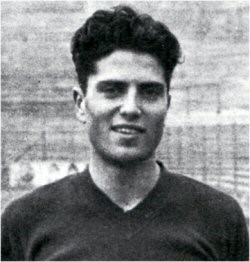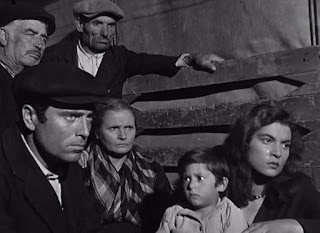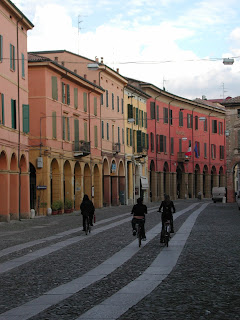Movie star who had four careers
 |
| Raffaele Vallone, pictured in a scene from the Giuseppe de Santis neorealist movie Bitter Rice |
Usually known as Raf, he grew up from the age of two in
Turin, where his father, an ambitious young lawyer, had relocated to set up a legal
practice. A natural athlete, he was a
fine footballer – so good, in fact, that at the age of 14 he was snapped up by Torino
FC, who made him an apprentice professional.
Compared with the average working man, he was handsomely paid
as a footballer, and he won a medal as part of the Torino team crowned Coppa
Italia winners in 1936. Yet he quickly
became bored with football and enrolled at Turin University, where he studied
Law and Philosophy with a view to joining his father’s firm.
Ultimately, he baulked at the idea of becoming a lawyer,
too, and instead joined the staff of the left-wing daily newspaper L’Unità,
where he rose quickly to be head of the culture pages, at the same time establishing
himself as a drama and film critic for the Turin daily La Stampa.
It was in his capacity as a journalist that he was invited
to meet Giuseppe De Santis, the film director, who wanted him to help with
background information for a new film in the growing neorealist genre called
Bitter Rice, about a woman working in the rice fields in the Po Valley.
 |
| Vallone in his days as a young footballer with Torino FC |
De Santis was immediately impressed with Vallone, who had
served with the anti-Fascist resistance during the Second World War, both for
his depth of knowledge but also for the passion of his views, particularly on
the subject of exploitation of workers.
The director also noted Vallone’s physical stature and his
rough-hewn features and decided he would be perfect for the role of a soldier
from peasant roots, competing with Vittorio Gassman for the love of another
relative unknown, Silvana Mangano. In fact, not only was Vallone an educated
man, his mother was descended from nobility, which only illustrates how appearances
can be deceptive.
The film, made in 1949, was a box office hit, commercially
one of the biggest successes of the neorealist era. Unlike some of the unknowns plucked from real
life, discarded after one movie, Vallone went on to enjoy a successful career.
He worked again with De Santis in 1950 in Non c'e Pace tra gli Ulivi (There’s No Peace Among the Olive Trees), playing a shepherd who
antagonised local Mafiosi, and in Rome 11 O'Clock (1952), based on a true story
of a rickety staircase that collapsed under a queue of unemployed girls hoping
for a job interview.
 |
| Raf Vallone (left) in a scene from Il Cammino della Speranza, in which he starred with his future wife, Elena Varzi (right) |
The popularity of neorealist films declined as Italy’s shattered post-War economy began to recover, when audiences decided they no longer wished to be
reminded of the hard times they had left behind. For a while, Vallone’s career
stalled.
Ever eager to try different things, however, Vallone now set
his sights on the stage. He travelled to
Paris and London, where he was inspired in particular by Peter Brook’s
production of the Arthur Miller play A View From the Bridge, in which he felt
the role of the Italian-American longshoreman Eddie Carbone, tormented by a sexual
fixation with a niece, was made for him.
He had the chance to play the character when Brook took the
play on tour to Paris. Vallone’s performances at the Theatre Antoine, where the
play ran for 550 nights, were frequently received with ovations from the audience,
and earned him the same part in Sidney Lumet’s 1961 film version of the play,
which he shot in both English and French.
That movie helped cement Vallone’s popularity with American movie-going
audiences. During that time he also gave
well received supporting roles in Vittorio De Sica’s Two Women (1960) and Anthony
Mann’s El Cid (1961), both co-starring Sophia Loren. Other actresses he
co-starred with on included Gina Lollobrigida, Anna Magnani, Melina Mercouri and
Simone Signoret.
In his later years, Vallone tended to play only cameos, such
as in The Italian Job (1969) and The Godfather Part III (1990). He also
directed for the stage, even trying his hand at opera with a production of Bellini’s
Norma, with Renata Scotto in the lead role.
Tropea, where Vallone was born, is for obvious reasons not a
resort that attracts many holidaymakers other than Italians. Situated on the
western coast of Calabria, the region that occupies the toe and the instep of
the Italian peninsula, it is more than 400km (250 miles) south of Naples and
though relatively close to Sicily – Messina is just 112km (70 miles) away – it tends
to be a place flown over en route. Yet
it has much to recommend it, from its beautiful soft sandy beaches to the
spectacular cliff-top setting of its historic old town, with its maze of narrow
streets and sleepy southern Italian feel.
On a stretch of scenic coastline known as the Costa degli Dei – the Coast
of the Gods – it is regarded by some regular visitors as one of Italy’s hidden
gems.
The rice fields of the Po Valley represent the largest rice
production area in the whole of Europe.
The Po Valley, or Po Plain, is vast, stretching about 650km (400 miles) from
the Western Alps to the Adriatic Sea, bordered by the Alps to the north and the
Apennines to the south, with an area of 46,000 sq km (18,000 sq mi). Rice production is mainly centred on the
province of Vercelli, between Milan and Turin, in which the town of Vercelli is
surrounded in the summer months by submerged paddy fields, for which water is
supplied by a canal from the Po River.
Rice has been grown in the area since the 15th century.
More reading:
Silvana Mangano - actress whose big break came with Bitter Rice
Vittorio De Sica and the neorealist masterpiece Bicycle Thieves
The earthy beauty of Oscar-winner Anna Magnani
Also on this day:
1600: The death of 'heretic' philosopher Giordano Bruno, burned at the stake
1653: The birth of composer Arcangelo Corelli
1796: The birth of composer Giovanni Pacini
More reading:
Silvana Mangano - actress whose big break came with Bitter Rice
Vittorio De Sica and the neorealist masterpiece Bicycle Thieves
The earthy beauty of Oscar-winner Anna Magnani
Also on this day:
1600: The death of 'heretic' philosopher Giordano Bruno, burned at the stake
1653: The birth of composer Arcangelo Corelli
1796: The birth of composer Giovanni Pacini
















